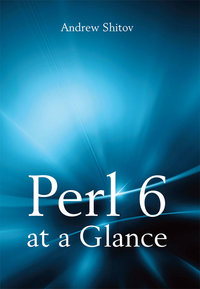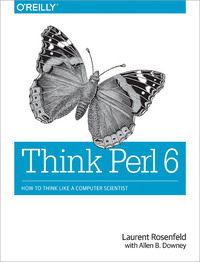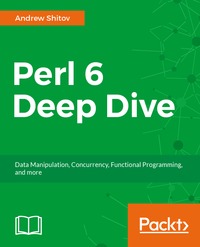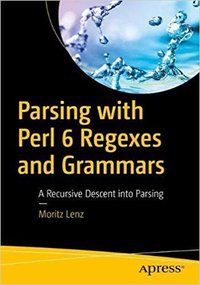We can quibble all day if 2017 was the year of the Linux desktop, but there can be little doubt that it was the year of the Perl 6 book.
Perl 6 at a Glance

December 2016 brought us the ebook launch of Perl 6 at a Glance by Andrew Shitov, and then in 2017 the print version came it. It is an introduction to Perl 6 that targets programmers already familiar with another language.
It is the first of a generation of “modern” Perl 6 books. There weren’t many Perl 6 books before, most notably “Perl 6 and Parrot Essentials”, which was written when Perl 6 was very much a language in flux. The December 2015 release of the Perl 6 language version v6.c (and the accompanying Rakudo Perl 6 compiler) finally offers enough stability to make Perl 6 books work.
Think Perl 6

The next book released in 2017 was “Think Perl 6: How to Think Like a Computer Scientist”. It is a Perl 6 adaptation of Allen Downey’s great book Think Python: How to Think Like a Computer Scientist, lovingly ported to Perl 6 by Laurent Rosenfeld. It is available in print from O’Reilly, and freely available as an ebook from Green Tea Press. It is also available under an Open Source license in its source form (LaTeX) on GitHub.
“Think Perl 6” is an introduction to programming and computer science that happens to use Perl 6 as its primary tool. It targets the absolute beginner, and goes into a lot of detail on basic concepts such as branches, loops, variables, expressions, functions, recursion and so on.
Learning to Program with Perl 6

A book I haven’t had on my radar until it was available for purchase on Amazon was Learning to program with Perl 6: First Steps: Getting into programming without leaving the command line by JJ Merelo. You can buy it on Amazon pretty cheaply, or check it out on GitHub, where you can find a musical as bonus material.
It mostly targets beginners, and also discusses some things related to programming, like the use of GitHub, some shell features, and SSH. It is a light-hearted introduction into computing and Perl 6.
Perl 6 Fundamentals

Perl 6 Fundamentals started its life as “Perl 6 by Example”, written by Moritz Lenz, aka yours truly. (Yes, authors write about themselves in the third person. That “About the Author” section in each book? Written by the author. In third person. Weird). When Apress acquired the book, it was renamed to Perl 6 Fundamentals: A Primer with Examples, Projects, and Case Studies. It is available from everywhere that you can buy books. At least I hope so :-)
Each chapter focuses on one (at least somewhat) practical example, and uses that as an excuse to talk about various Perl 6 features, including concurrency, functional programming, grammars, and calling Python libraries through Inline::Python. (You can read the chapter about Inline::Python over at perltricks.com.) It targets programmers with previous experience, though not necessarily Perl 6 (or Perl 5) experience.
Larry Wall has kindly written a foreword for the book.
Perl 6 Deep Dive

Andrew Shitov’s second Perl 6 book, Perl 6 Deep Dive is, as the name suggests, more comprehensive and a, well, deeper dive, than “Perl 6 at Glance”, though somewhat similar in style. With more than 350 pages, it seems to have the largest coverage of Perl 6 features of any book so far.
Using Perl 6

Guess who’s released a third Perl 6 book within one year? That’s right, Andrew Shitov again. Somebody give that man a medal! Using Perl 6 is a collection of 100 programming challenges/problems and their solution in Perl 6. This is what Andrew wrote about it:
About a year ago, I decided to write a book about using Perl 6. Later, the plans changed and I published “Perl 6 at a Glance”, after which I wanted to write “Migrating to Perl 6” but instead wrote “Perl 6 Deep Dive” for Packt Publishing. Here and there, I was giving trainings on Perl 5, Python, and JavaScript, and was always suffering from finding a good list of easy tasks that a newcomer can use to train their skills in the language. Finally, I made up the list and solved it in Perl 6. This is the content of “Using Perl 6” — a book with solutions to 100 programming challenges, from simple to intermediate, with explanations of the Perl 6 constructions used.
Since his fourth book, *Migrating to Perl 6 will be released in 2018, it doesn’t get its own section. Take that, Andy! :-) This is the “Perl 6 for Perl 5 programmers” book that people (Perl 5 people, mostly) have been asking for on IRC and some other media.
And of course I won’t mention Andrew’s kickstarter for a cookbook-style project, because that will further skew the stats. Ooops, I just did. Hmm. Well, go support the man!
Parsing with Perl 6 Regexes and Grammars

After writing a general Perl 6 book, I wanted to focus on a narrower topic. A non-representative poll on twitter confirmed my suspicion that regexes and grammars would be the best niche, and so Parsing with Perl 6 Regexes and Grammars: A Recursive Descent into Parsing was born.
It requires basic programming knowledge to read, but no prior exposure to regexes to Perl. It goes from the building blocks of regexes to fully-featured parsers, including Abstract Syntax Tree generation and error reporting. A discussion of three very different example parsers concludes the nearly 200 pages, which could have also been titled far more than you ever wanted to know about parsing with Perl 6.
Right now, the ebook version is available for purchase, and I hope that the print version will be ready by Christmas. (And I’m talking about Christmas 2017, to be sure :)
Books in the Pipeline
I’d be remiss if I didn’t point out two more books that aren’t available yet, but might be in the next months or years.
brian d foy works on Learning Perl 6. In his last update, he shares that the first draft of the book is written, with a plan for things that need rewriting.
Gabor Szabo crowd-funded a book on Web Application Development in Perl 6 using the Bailador framework. The earlier chapters are mostly fleshed out, and the later chapters mostly exist as skeletons. Gabor expects it to be finished in 2018.
Keeping Track
The flood of Perl 6 books has made it hard for newcomers to decide which book to read, so I created the https://perl6book.com/ website that has one-line summaries, and a flow-chart for deciding which book to buy.
Even though I had input from other Perl 6 authors, it certainly reflects my biases. But, you can help to improve it!
Summary
With 7 Perl 6 books published by three major publishers in 2017, it’s been a fantastic year. I am also very happy with the diversity of the books, their target audience and styles. I hope you are too!
A final plea: If you have read any of these books, please give the author some feedback. They put incredible amounts of work into those, and feedback helps the author’s learning process and motivation. And if you liked a book, maybe even give it 5 stars on Amazon and write a line or two about why you liked it.

Already read several of them (thoroughly or the most): Think Perl 6, Deep Dive, 100 Problems, Perl 6 at a Glance. Reading now Parsing with Perl 6.
My greatest thanks to the authors for their awesome work!
Already read several of them (thoroughly or the most): Think Perl 6, Deep Dive, 100 Problems, Perl 6 at a Glance. Reading now Parsing with Perl 6.
My greatest thanks to the authors for their awesome work!